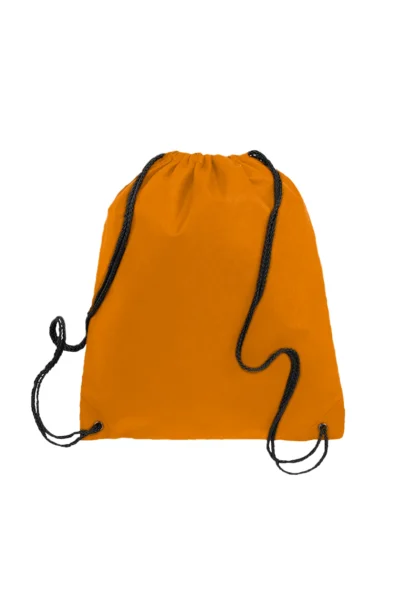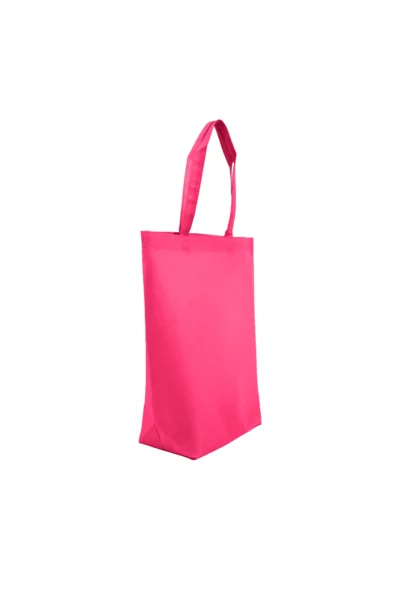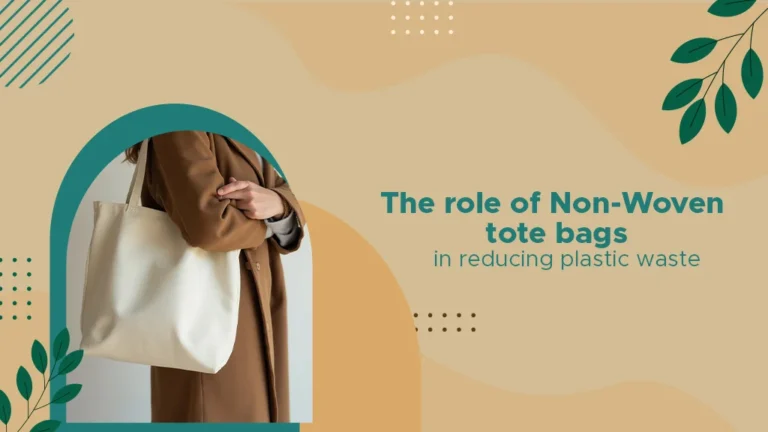How Non Woven Tote Bags are Made
How Non-Woven Tote Bags are Made Whether you’re heading to the…
How Non-Woven Tote Bags are Made
Whether you’re heading to the supermarket or taking books to class, a tote bag can make transporting your belongings much easier. Whatever you choose to fill them with, they will always be there to provide a hand. While tote bags are available in several materials, some of the most popular are made of plastic! In reality, a lot of the clothes we wear are made of plastic, from imitation leather coats to nylon stockings to polyester sweaters.
What is the method for producing totes? What is the relationship between plastic and fabric? Prepare to learn how to make these easy-to-carry totes.
If you are more visual watch how non woven totes are made.
video credit Quality Logo Products
What Are Non-Woven Fabrics?
Fabric from your local supermarket or craft store is used to put the majority of woven tote bags together. Weaved bags are typically simple to construct in the comfort of your own home because the cloth has already been produced and treated.
Non-woven textiles, on the other hand, are essentially plastic disguised as cloth, and their name comes from the production method. Non-woven textiles are made up of microscopic fibers or molten plastic that have been chemically, thermally, or physically glued together during manufacture instead of thread.

Non-woven textiles have a wider range of applications than woven materials. Stretchability, resilience, strength, softness, and cushioning are all features they offer. Non wovens are also used to produce diapers, bed sheets, dusters, dryer sheets, tea bags, bandages, and a whole lot more!
Which Type of Plastic is Used to Make Non-Woven Fabrics?
Non-woven tote bags are primarily composed of polypropylene, however, some are made of polyester. This is because this form of plastic is easy to manipulate, has excellent properties such as strength and durability, and is very inexpensive. In reality, there is a slew of benefits to utilizing polypropylene for tote bags:
- Less Expensive
- Water-Resistant
- Sustainable
- Durable
- Chemical-Resistant
Less Expensive
In most cases, polymers are valued based on their mass. Polypropylene is a very cost-effective plastic to use since it is not dense and has one of the lightest weights of all the polymers.
Water-Resistant
Polypropylene, unlike highly absorbent fabrics like cotton, is unable to absorb moisture. This makes it easy to wipe clean or wash tote bags as needed.
Sustainable
Polypropylene, believe it or not, needs less fuel and emits fewer pollutants during production. Because tote bags are reusable, they help to reduce the quantity of CO2 emitted into the sky.
Durable
Polypropylene fibers have a high elasticity. The material’s elasticity helps it to keep its shape even after twisting, bending and stretching, ensuring that your tote bags survive for years.
Chemical Resistant
While tote bags should be washed often, polypropylene tote bags are chemically resistant. As a result, you won’t have to worry about odors from other objects, such as dirty workout socks, seeping into the fabric.
What is Melt Spinning?
The fact that non-woven textiles are manufactured using a method called melt spinning is one of the reasons for their low cost and sustainability. Because this method is basic, uncomplicated, and involves the use of heat, there is practically little pollution produced during the production of polypropylene non-wovens. The whole process also avoids the use of solvents (dyes) or purifying operations, making it more cost-effective and allowing for a shorter turnaround time.
Take a look at this picture to better comprehend melt spinning:
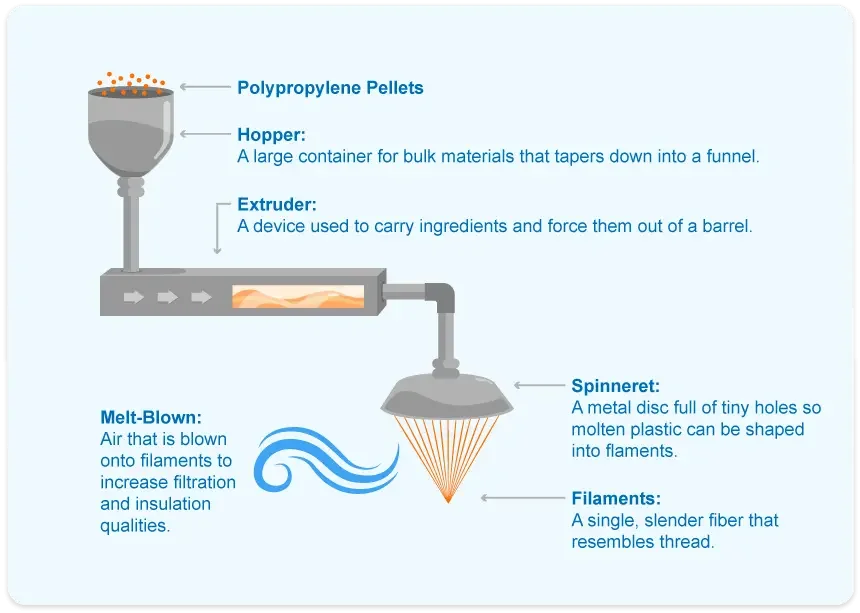
To make the tote bags, small plastic pellets are flung into a hopper and heated to nearly 500 degrees Fahrenheit, where they melt into a syrup-like liquid. To make filament fibers, the molten plastic is extruded and forced through a spinneret.
Air is blasted onto the filaments as they are pushed out of the spinneret, and a machine begins spinning the separate threads together. Spunbonding causes the fibers to entangle, resulting in uniform sheets of fabric being produced when pushed onto the conveyor belt.
Melt spinning is only utilized to manufacture specific polymers such as nylon, polyester, and polypropylene since some polymers break down or deteriorate at high temperatures. When heated, these polymers, unlike the others, transform into molten liquid. These polymers could not be converted into synthetic fibers without this procedure.
Tote Bags Glossary
Knowing how plastic is used and the process it goes through is just the beginning! Other terms are important to know when it comes to how tote bags are made.
Fibers
Long, thin material used to manufacture other textiles; looks like feathers when cut.
Gusset
The triangular piece of fabric on the sides of your tote bags was inserted to had strength and durability.
Heat Transfer
A printing process that uses high temperatures to transfer your logo onto fabric; also called a heat press.
Imprint
The imprint area is one of the most important parts of a promotional product because it’s the spot where your logo or message is printed.
Polymer
Large molecules make up chains of plastic, including polypropylene and polyester.
Roll Goods
Fabric that has been rolled up after it’s gone through the manufacturing process so it can be stored for the future or used right away.
Screen Printing
Spreading a wax-like material called an emulsion across a screen is the method for printing logos onto objects.
While there is a lot of technical terminologies involved, tote bags are adaptable and trustworthy because of these characteristics. Tote bags would not have a fabric-like consistency, strength, or durability without techniques like spun melt or inventions like a gusset.
How Are Custom Tote Bags Made?
Now that you know more about how non-woven totes get their name and terms associated with the manufacturing process, let’s learn more about each unique step!
- Plastic polypropylene pellets are melted and pushed through a spinneret to make filaments
- Filaments are laid down onto a conveyor belt to be pressed into sheets
- Once cooled, the sheets are rolled up into giant rolls of fabric
- When the fabric is ready to be made into a tote bag, it’s measured and cut to shape
- The seams and handles of the tote are heat-sealed or sewn together
- The finished tote bags will get decorated with a custom logo, usually by screen printing or heat transfer
Step 1

Tiny pieces of polypropylene plastic are melted and pushed through a spinneret. This causes the molten plastic to turn into very thin fibers known as filaments.
Step 2
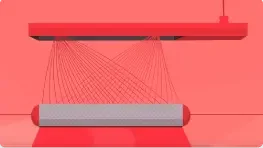
The filaments are laid down onto a conveyor belt where they are pressed into sheets. Afterward, the sheets cool down before the next step.
Step 3

Once cooled, the sheets are rolled up into giant rolls of fabric. From here, they can be stored until they’re ready to be used!
Step 4

When the fabric is ready to be made into a tote bag, it’s measured accurately and cut to shape. Since totes come in all different shapes and sizes, measurements can easily be altered to get the desired size.
Step 5
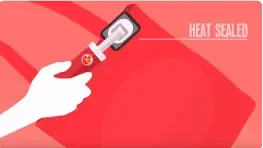
Next, the seams of the tote, as well as the handles, are typically heat sealed. This means the heat will be applied with pressure to form an attachment. Depending on the manufacturer or the bag, the seams can also be sewn together.
Step 6

The tote bags are now done and ready to be adorned! Your logo will be placed in the middle of the tote bag at this stage, generally by screen printing or heat transfer. You may either use one side of the tote bag to display your unique design or go all out and use both sides.
Step 7

Your tote bags look terrific and are ready to be packaged. They’ll be laid flat in boxes, shipped, and sent your way!
FUN FACT: Non-woven fabrics are created at 1000 feet per minute!


